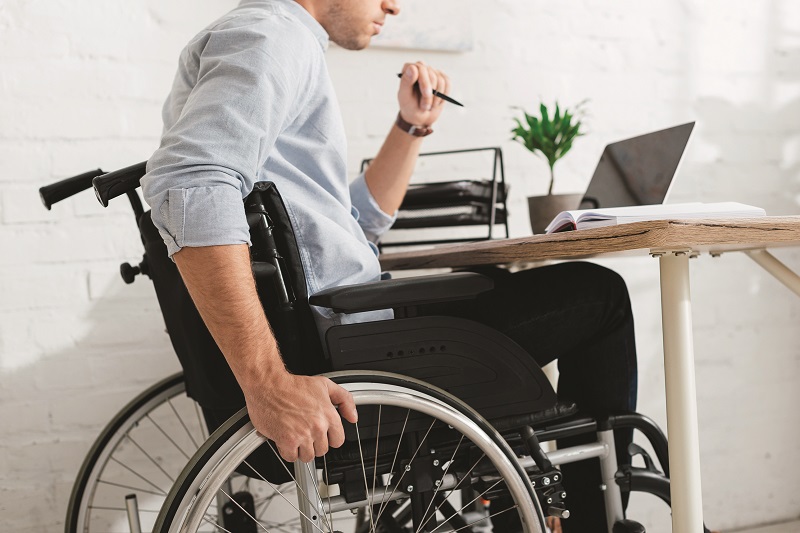- Economy
- Education And Career
- Companies & Markets
- Gadgets & Technology
- After Hours
- Healthcare
- Banking & Finance
- Entrepreneurship
- Energy & Infra
- Case Study
- Video
- More
- Sustainability
- Web Exclusive
- Opinion
- Luxury
- Legal
- Property Review
- Cloud
- Blockchain
- Workplace
- Collaboration
- Developer
- Digital India
- Infrastructure
- Work Life Balance
- Test category by sumit
- Sports
- National
- World
- Entertainment
- Lifestyle
- Science
- Health
- Tech
Inclusivity
There are several such cases at home too. Arunima Sinha – who had to get her leg amputed after she was pushed out of a running train – climbed the Everest with her prosthetic foot. Ira Singhal, who suffers from a spinal disorder – qualified for the IAS in 2010 but was denied a job due to her disability. She took the government to court over this
Photo Credit :

To my mind, the two biggest problems faced by the world today are Climate Change (cause celebre of Sustainability) and Inclusivity. All progress that humanity is making by way of scientific break-through, industrialisation, new discoveries, innovations, space exploration, medical sciences, digitisation, artificial intelligence et al can come to naught if we fail to (a) arrest the march of climate change and (b) ensure that all economic gains percolate down to the bottom of the pyramid and are distributed reasonably fairly between countries, states and regions within the country, rural and urban areas, even within the same village between farmers who become super rich by selling their lands for industry and others who continue to till their small parcels of land, different sections of society, people with disabilities and gender parity etc. There has to be adequate balance in jobs both in the government and in the private sector, blue collar and white-collar employment, factories and offices, market places, infrastructure building, utilities like electricity, water, railways, transportation, R & D, cyber spaces, police, paramilitary and defence forces, teaching, hospitals, the performing arts, even admission to institutes of higher learning like the IITs, IIMs, medical colleges, etc. etc.
Having devoted almost all my columns, during the last seven or eight months, to ‘sustainability’, I thought I would take a break from that theme and begin sharing my thoughts on ‘inclusivity’. I plan to devote dedicated columns to areas with more glaring disparities, unsung and invisible champions who are trying to correct the situation and other issues that develop along the way. For this first column in the new series, I will just flag the critical issue of creating a level playing field for PwDs (Persons with Disabilities) or Divyangjan ‒ as our prime minister refers to these people whom nature has denied some faculty or the other.
Dimensions of the problem ‒ how many PwDs are there in the country ‒ is under a haze. A Census in 2011 had come up with the figure of 28 million but, as we are all aware, this is grossly underestimated. I wouldn’t blame the census officials because our society hides the fact that there is a child in their home who is not gifted with the power of vision, hearing, speech, mobility, cerebral palsy, epilepsy, motor neuron disease or has any other symptoms of not being a normal child. There are unfortunate superstitions that all such impairments are a curse of God and such children don’t deserve to be seen by neighbours or even the extended family. This is especially so in the villages where they will resort to all kinds of jadu-tona, jhar-ponchh and other stuff that the quacks engage in.
Organisations working in the area of empowering PwDs and making them self-dependent and an asset to society – rather than remaining a burden – soon came up with an estimate of about 100 million such cases in the country. Studies by WHO and the World Bank, around 2020, validated these estimates and reported that between 100 to 120 million Indians suffered from some sort of disability! An article in the Times of India of 2 July actually mentioned that the already delayed new census will simply drop disability related questions from the sixth National Family Health Survey. This is a big setback as everyone was actually trying to make the new survey more structured with questions about all 21 disabilities under the ‘Rights of Persons with Disabilities Act 2016’ as against only five included in the earlier surveys. Here’s hoping better sense will prevail and our Divyangjan will get a fair deal. There will, of course, still be the hassles of getting certification about ‘minimum 40 per cent disability’ to become eligible for government benefits.
Indeed, there are well meaning NGOs all over the country who are trying to bring them out in the open, impart skills to these less fortunate members of society and find suitable jobs for them in the corporate world or in government departments. Some of them also have ‘early intervention centres’ so that the child’s conditions are scientifically assessed and corrective measures taken so that their disease is arrested and rehabilitation process is quicker. But the numbers are so large that we need at least 500X effort in the area. On paper there are ‘reservations’ for about 2.5 per cent of the jobs to go exclusively to PwDs but ground realities are different. There is an independent ‘Department of Empowerment of Persons with Disabilities, headed by a full secretary, under the Ministry of Social Justice & Empowerment’ and they are doing great work but we need much more by way of financial allocations and trained manpower to be able to touch the lives of all PwDs in the country.
I will take up all issues in subsequent columns but, let me end this by citing some cases of exceptional super- achievers amongst the so-called ‘disabled’ to make the point that they don’t need sympathy and charity; they only want a ‘level playing field’ by way of physical accessibility and schools where they can study and offices and factories where they can work. Most of them have a huge ‘fire in the belly’ and they are raring to show their capabilities – often at par with their ‘able bodied’ colleagues. Eco system for support is much better in western countries and that’s why more of them achieve success there than in our own country.
The subject of ‘super achievers’ amongst the handicapped is fascinating. On top of my mind are names like (i) Stephen Hawking (1942-2018) who contracted a motor-neuron disease at the age of 21, was given just two years to live, but went on to become one of the most distinguished professors at Cambridge, physicist, cosmologist and brilliant author of immortal books like ‘A Brief History of Time’ (ii) Stevie Wonder (born 1950) who became visually impaired just six weeks after birth due to a faulty incubator and yet trained himself to be one of the greatest singers the world has seen (iii) Helen Keller (1880-1968) – struck with a mysterious disease when she wasn’t even two, due to which both her vision and hearing abilities were impaired; and she ended up becoming a charismatic motivational speaker, author and strong advocate for the differently abled (iv) Louis Braille (1809-1852) who lost vision in both eyes due to an accident in early childhood and went on to develop ‒ at the young age of 15 – the revolutionary ‘Braille System of Reading’ for those who cannot see; the system that has stood the test of time for two centuries and still remains the bedrock of learning for the visually challenged (v) Franklin D. Roosevelt (1882-1945) 32nd president of the USA was paralysed at the age of 39 due to poliomyelitis, but was a distinguished POTUS despite being wheelchair-bound.
There are several such cases at home too. Arunima Sinha ‒ who had to get her leg amputed after she was pushed out of a running train – climbed the Everest with her prosthetic foot. Ira Singhal, who suffers from a spinal disorder – qualified for the IAS in 2010 but was denied a job due to her disability. She took the government to court over this; meanwhile she worked briefly in IRS, completed an MBA programme, worked with Pepsi for a while and kept clearing the IAS exams repeatedly in 2011, 2013 and finally in 2014 when she topped and also won her legal battle; she is today a role model for new aspirants. Sudha Chandran lost one leg due to gangrene following a road accident but went on to become an accomplished dancer and actor. I am sure there are many more.
How did all these people manage to achieve distinction? Firstly, they believed in themselves, they dared to dream big and knew they could do it; they also had a strong resolve to accomplish and were fortunate to get encouragement and support. Despite failures, humiliation, lack of physical access to many places and facilities, rejection at many steps, indifferent attitude of employers and colleagues etc.; they just didn’t give up and carried on relentlessly.
Author is Member, National Advisory Board, Sarthak and President, National Abilympic Association of India (NAAI)
Disclaimer: The views expressed in the article above are those of the authors' and do not necessarily represent or reflect the views of this publishing house. Unless otherwise noted, the author is writing in his/her personal capacity. They are not intended and should not be thought to represent official ideas, attitudes, or policies of any agency or institution.

Krishan Kalra
The author is President NAAI and Member National Advisory Board SARTHAK
More From The Author >>